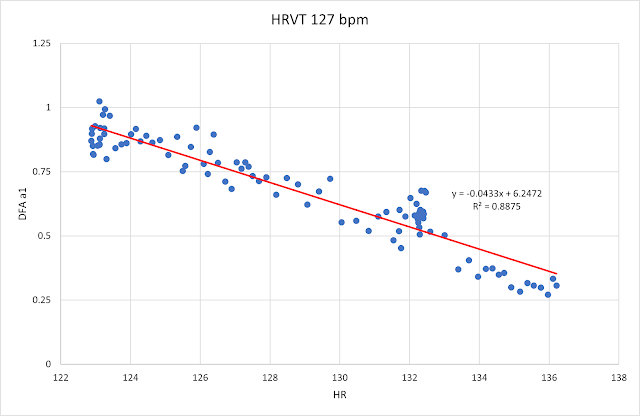I was recently asked to evaluate a blog reader who had high artifact RR recordings. This is the way it looked:
We are seeing near 5-10% artifact rates with occasionally higher values. Potential causes include poor contact, low battery, arrhythmia, module failure or non optimal belt position. To track down the cause, the athlete was asked to record a ramp session with software that records an ECG from the Polar H10.
Here are the results:
What we are seeing here is a very low R peak amplitude, so low that some beats are not even counted properly (yellow marks).
Since the R peak has a low signal to noise ratio, the DFA a1 can't be properly determined. Recall that this index is based on correlation patterns of beat to beat timing - if the timing is not precise, the correlations will be lost. Kind of like looking through a dirty camera lens or set of eyeglasses and not recognizing a persons face.
Here is the DFA a1 result-
- The bottom panel (black) is the DFA a1, which is all over the map, no relation to heart rate (blue). The top panel shows the ECG and artifacts (tiny vertical lines) which are above 5%.
How do we fix this?
- Just invert the signal polarity in the preference settings of Kubios.
This is what the result yields:
- Now DFA a1 is gradually dropping as HR rises.
- Notice also that all the artifacts are gone - not a single one is present!
- The ECG strip on the top panel shows good R peaks.
- Excellent regression plot of HRVT.
Unfortunately, the H10 does not auto invert the signal.
To compensate, this user should flip the module (Polar logo upside down) to reproduce the software polarity inversion I did.
More info from Polar (even they recommend these mods):
Bottom line:
- Some users of chest belt HR monitors will need to either invert the module or move it to the left to optimize the signal.
- Usage of Fatmaxxer (Android) or one of the Polar H10 ECG logging apps (ios) can help one perform this type of assessment.
- Although I can't say how common this type of issue is, it probably occurs more often than we think.
- Going forward in DFA a1 monitoring, I recommend an initial signal optimization protocol to help produce the most precise a1 values. Besides the issue of proper software detrending (as Runalyze, Fatmaxxer and AI endurance are doing), signal optimization may help you reproduce published findings.


.png)
.png)


Bruce, great analysis.
ReplyDeleteTo correct, would inverting the chest strap and keeping the module in the normal orientation have the same affect as flipping the module?
No, the strap is just a set of wires, polarity is determined by the module.
DeleteThanks, that makes sense.
Delete